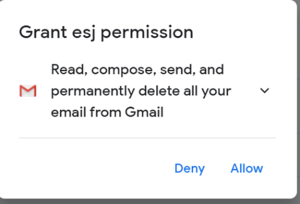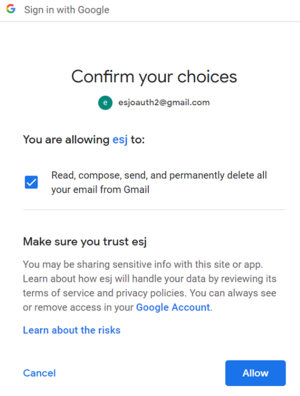password
Section: secret-<secretName>
Default Value: No default value
Valid Values: The Google application client_secret value when an account is registered in Google
Changes Take Effect: At the next POP cycle for a POP client (pop-client) or at start/restart for an SMTP client (smtp-client)
Introduced: 8.5.201.05
Specifies the client_secret value of the corresponding Google application associated with the mailbox or the SMTP account.
tenant-authority
Section: pop-client
Default Value: https://login.microsoftonline.com
Valid Values: The valid Microsoft authority server is https://login.microsoftonline.com. The valid Google authority server is a case-insensitive string that contains "google".
Changes Take Effect: At the next POP cycle
Introduced: 8.5.107.06
Modified: 8.5.201.05, 8.5.202.02, 8.5.205.03
Specifies the authority server of the registered Microsoft Azure application for the Office 365 or the Google application for the Gmail mailbox in the corresponding POP client. This parameter takes effect only when the mail.<type>.auth.mechanisms is set to XOAUTH2 or type is GRAPH.
secret
Section: pop-client
Default Value: No default value
Valid Values: Any string without the white space
Changes Take Effect: At the next POP cycle
Introduced: 8.5.201.05
Modified: 8.5.202.02
Specifies the secretName of the secret-<secretName> section to associate with the Google application secret after the mailbox is registered in Google. This is a Gmail-only option when a mailbox is OAuth 2.0 enabled (mail.<type>.auth.mechanisms is XOAUTH2).
password
Section: pop-client
Default Value: No default value
Valid Values: A valid password or refresh_token
Changes Take Effect: At the next POP cycle
Modified: 8.5.205.03
Specifies the password associated with this account for basic authentication and OAuth2 enabled (mail.[type].auth.mechanisms is XOAUTH2) for a Microsoft Azure mailbox.
You set this value during the E-mail Server setup.
For Gmail, if a mailbox is OAuth2 enabled (mail.[type].auth.mechanisms is XOAUTH2), this option is used for the refresh_token of the mailbox.
For Outlook, if the type is GRAPH or grant-type is client_credentials, this is used for the Azure application secret.
client-id
Section: pop-client
Default Value: No default value
Valid Values: A valid Client ID of the Microsoft Azure or Google application provided by the customer after the mailbox is registered in Microsoft Azure or Google
Changes Take Effect: At the next POP cycle
Introduced: 8.5.107.06
Modified: 8.5.201.05, 8.5.202.02, 8.5.205.03
Specifies the Client ID of the registered Microsoft Azure application for the Office 365 mailbox or the Google application for the Gmail mailbox in the corresponding POP client. This parameter takes effect only when the mail.<type>.auth.mechanisms is set to XOAUTH2 or type is GRAPH..
tenant-authority
Section: smtp-client
Default Value: https://login.microsoftonline.com
Valid Values: The valid Microsoft authority server is https://login.microsoftonline.com. The valid Google authority server is a case-insensitive string that contains "google".
Changes Take Effect: At start/restart
Introduced: 8.5.107.06
Modified: 8.5.201.05, 8.5.202.02, 8.5.205.03
Specifies the authority server of the registered Microsoft Azure application for the Office 365 or the Google application for the Gmail SMTP account in the SMTP client. This parameter takes effect only when the mail.<server-type>.auth.mechanisms is set to XOAUTH2 or type is GRAPH.
secret
Section: smtp-client
Default Value: smtp
Valid Values: Any string without the white space
Changes Take Effect: At start/restart
Introduced: 8.5.201.05
Specifies the secretName of the secret-<secretName> section to associate with the Google application secret after the SMTP account is registered in Google. This is a Gmail-only option when an SMTP account is OAuth 2.0 enabled (mail.smtp.auth.mechanisms is XOAUTH2).
password
Section: smtp-client
Default Value: No default value
Valid Values: A valid password or refresh_token
Changes Take Effect: At start/restart
Modified: 8.5.201.05, 8.5.205.03
Specifies the password associated with this account for basic authentication and OAuth2 enabled (mail.[type].auth.mechanisms is XOAUTH2) for a Microsoft Azure mailbox.
You set this value during the E-mail Server setup. This applies only when Template loop detected: Template:Optionslink is set to true.
For Gmail, if a mailbox is OAuth2 enabled (mail.smtp.auth.mechanisms is XOAUTH2), this option is used for the refresh_token of the SMTP account.
For Outlook, if the type is GRAPH or grant-type is client_credentials, this is used for the Azure application secret.
client-id
Section: smtp-client
Default Value: No default value
Valid Values: A valid Client ID of the Microsoft Azure or Google application provided by the customer after the mailbox is registered in Microsoft Azure or Google
Changes Take Effect: At start/restart
Introduced: 8.5.107.06
Modified: 8.5.201.05, 8.5.202.02, 8.5.205.03
Specifies the Client ID of the registered Microsoft Azure application for the Office 365 or the Google application for the Gmail account in the SMTP client. This parameter takes effect only when the mail.<server-type>.auth.mechanisms is set to XOAUTH2 or type is GRAPH.
Setting up Gmail mailboxes for OAuth 2.0 authorization
For basic authentication, Genesys E-mail Server can access Gmail mailboxes using the IMAP, POP3, and SMTP protocols.
Starting with version 8.5.201.05, E-mail Server supports the OAuth 2.0 authorization access to Gmail mailboxes with the IMAP and SMTP protocols. Starting with version 8.5.202.02, OAuth 2.0 support is extended to POP3 and SMTP protocols.
To set up Gmail mailboxes using the OAuth 2.0 authorization access:
Creating a Google application
For OAuth 2.0 authorization access to Gmail mailboxes with IMAP, POP3, and SMTP protocols, create a Google application in the Google platform. (In our example, the esj account is created.)
- Follow this Google documentation to configure the application. The main configuration points are included in this procedure.
- Select Desktop as an application type. E-mail Server uses "Manual copy/paste" as the redirect method.
- Download the client_id and client_secret by clicking the Download arrow of your Google application. These values are required to get the access token and to configure Genesys E-mail Server.
- On the OAuth consent screen, add your App information (App name, User support email). For example:
- In the Scope step, enter the Gmail scope as Your restricted scopes.
- (Optional) Add test users. This step is for the testing phase. You can add an existing or new mailbox that the E-mail Server can access as a user. The application must be published after the testing phase before it can be used in production.
- Get a refresh token manually. Follow the steps as described in
this Google documentation to get the OAuth 2.0 refresh token:
- Step 1: Generate a code verifier and challenge. (Note: A refresh token can be acquired without this step.)
- Step 2: Send a request to Google's OAuth 2.0 server. In a web browser, enter the following as a URL, replacing <your client id> with your application client ID:
https://accounts.google.com/o/oauth2/auth?scope=https://mail.google.com/&redirect_uri=urn:ietf:wg:oauth:2.0:oob&response_type=code&client_id=<your client id>
- Note that redirect_uri and response_type values cannot be changed.
- Step 3: Google prompts the user for consent. You will be prompted to sign in with a mailbox if it was not signed in. In the test phase, if you have multiple mailboxes, only the mailboxes that have been added as Test Users can access the application. This may change after the application is published. After signing in with mailbox credentials, there will be an alert in the test phase. Click Continue:
- Click Allow:
- Click Allow:
- The Authorization Code is displayed. Copy the Code by clicking Copy Icon:
- Step 4: Exchange authorization code for refresh and access tokens.
- The Authorization Code acquired in Step 3 can be used to exchange for OAuth 2.0 access and refresh tokens within 10 minutes (after you received the authorization code) by means of the following command:
curl -d "code=<your authorization code>&grant_type=authorization_code&redirect_uri=urn:ietf:wg:oauth:2.0:oob&client_id=<your client_id>&client_secret=<your client secret>" -X POST https://oauth2.googleapis.com/token
- Replace <your authorization code>, <your client_id>, and <your client_secret> with the actual values of your application. Keep the rest as is.
- Here is an example of the response:
- {
- "access_token": "ya29.a0AfH6S7ztJBShUiXC-z7P_-*************************",
- "expires_in": 3599,
- "refresh_token": "1//06LxPX1ZCgYIARAAGAYSNwF**************************",
- "scope": "https://mail.google.com/",
- "token_type": "Bearer"
- }
- The Bearer access_token, which can be used to access the mailbox in IMAP/POP3/SMTP, expires every 3600 seconds. The refresh_token can be used to get a new Bearer token. After the application is published, the refresh code will only expire under the conditions listed in this Google document.
Configuring Genesys E-mail Server
To configure E-mail Server:
- Set the JavaMail property mail.<type>.auth.mechanisms (where <type> can be imap, pop3, and smtp) to XOAUTH2. (To disable OAuth 2.0, remove the JavaMail property.)
- Configure options in the smtp-client section.
- Configure options in the pop-client section.
- Configure options in the secret-<secretName> section.
Configuring the smtp-client section
Configure the following configuration options:
- client-id—Specify the Client ID of the Google application.
- password—Specify the refresh_token of the SMTP account.
- secret—Specify the secretName of the secret-<secretName> section to associate with the Google application secret.
- tenant-authority—Specify the valid Google authority server, which is a case-insensitive string that contains "google".
Configuring the pop-client section
Configure the following configuration options:
- client-id—Specify the Client ID of the Google application.
- password—Specify the refresh_token of the Gmail mailbox.
- secret—Specify the secretName of the secret-<secretName> section to associate with the Google application secret.
- tenant-authority—Specify the valid Google authority server, which is a case-insensitive string that contains "google".
Configuring the secret-<secretName> section
- password—Specify the client_secret value of the registered Google account.
Limitations
- During the test phase, a refresh token expires in 7 days.
- During the test phase, the refresh token may stop working if the Gmail mailbox is not used for a few days.








